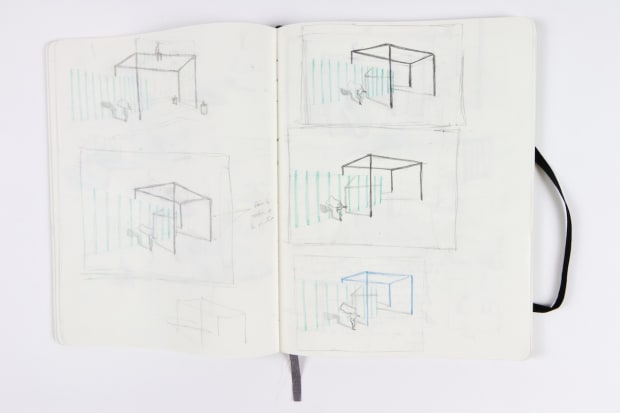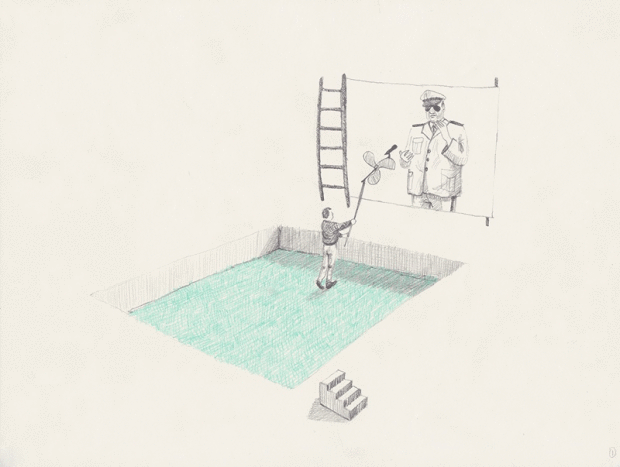Kate Macfarlane is a curator and writer based in London who began her career in the public visual arts sector at Riverside Studios London in 1984. She co-founded Drawing Room in 2000 and since that time has co-devised the organisation’s vision and programme. Recent exhibitions include ‘Close: Drawn Portraits’ at Drawing Room; ‘A Slice through the World: Contemporary Artists’ Drawings’ at Drawing Room and Modern Art Oxford; ‘Line’ at Lisson Gallery, London, and ‘Dove Allouche - Mea Culpa of a Sceptic’, The Fondation d’entreprise Ricard, Paris.
On this online viewing room we will be sharing with you the interview of Kate Macfarlane with Massinissa Selmani, along side his new drawings and his Sketchbooks.
-

Massinissa Selmani
éclat, 2020
Graphite and colored pencil on paper
50h x 65w cm
-

éclat, sketchbook - preparatory drawings - 2020
-
Massinissa Selmani's, Solo Exhibition at CCC OD Tours
-

Pretextes, 2019
Looped animation, no sound (Duration 35 seconds)
-
MS: This context is actually the result of the haphazard nature of my imagination and the associations I choose. However, I think that the mise-en-scènes include postures, situations or architectural configurations that seem familiar but cannot be situated. It is at this point that the spectator's imagination interacts with mine, to expand or confront it.
Usually I start by composing situations around which spaces are built and I have the feeling that this logic is reversed in the two drawings you mention and it is also valid in some others. In my research sketchbooks I frequently draw spaces with impossible or ambiguous configurations made of fragments of architecture or territories emerging from my memory, visual sources or partially invented ones, which become potential starting points for drawn forms. This can even extend to the scale of an exhibition, as was the case during my solo exhibition at the CCC OD in Tours, where the matter of landscape and its representation was present throughout a part of the exhibition. I continue to be interested in this question and more generally in the representation of unfathomable spaces. There is also a progressive evolution in my work linked to my approach to drawing itself; on the one hand, the desire to include a more detached graphic writing, in much the same way as in my sketchbooks, and on the other hand, the outlines that tend to disappear in recent drawings.
I use the presence or absence of shadows to suggest spaces. Also, when I retain the shadows of elements taken from the press, they are contradictory since they come from different sources, which accentuates the theatricality of the mise-en-scène.
-
KM: Let’s talk more specifically about your drawing methodology. There is no pentimenti in your finished drawings – you are using, as you describe, ‘a more detached graphic writing’. Yet looking closely at your drawings each mark is extremely loose and lively – this is perhaps most visible in “Pretexes” - your new animation. This tightrope that you walk between extreme control and frenetic energy seems to parallel the dialectic nature of your enquiry. Can you describe in more detail the drawn process and the time it takes?
MS: My sketchbooks are mainly used to make drawing notes for potential projects. I like to consider drawing as the first documentary form. I make drawings in pencil and coloured pencil on paper and tracing paper, some of which I animate. Others I situate alongside objects to create installations. These different forms create narratives.
The series of autonomous drawings came later in my practice; the first time I drew complex, figurative drawings was only a few years ago. These drawings are the fruit of a long process nourished by experimenting with different approaches to drawing. The preparatory drawings that precede them are made, as explained above, with the help of taking elements (such as characters or fragments of architecture) from press photographs redrawn on pieces of tracing paper - a medium I like - to form a composition. I apply adhesive to these fragmentary drawings and try them in different positions on the paper. I refer to the notes in my notebook, use accident, trial and error and erase or redraw elements to form the final composition. Once the preparatory drawing is finished, I transfer the outlines onto a new sheet of paper via a light table, in the manner of a comic book draughtsman. Only then do I start working on the final version of the drawing. I conserve a large majority of these preparatory drawings, some of which serve as a graphic basis for other drawn forms.
The animations, the research for which is done almost exclusively in the notebooks, are built around a short action, often absurd or comic, which is repeated in a loop. They are made using the frame-by-frame technique and their final appearance is similar to the sketches in the notebooks, making them in my opinion more dynamic and somehow reinforcing their burlesque dimension. Although they are often of short duration (a few seconds), they require a long series of drawings. The choice of a relaxed drawing in the making is also due to the constraint of repeating drawings that gradually change to give the illusion of movement. It also has the advantage of leaving trails that give fluidity to the animation.
-
Sketchbook - Preparatory drawings - Boussole
-

Massinissa Selmani
Boussole, 2020
Graphite and colored pencil on paper
50h x 65w cm
-

Massinissa Selmani
échappées, 2020
Graphite and colored pencil on paper
50h x 65w cm











